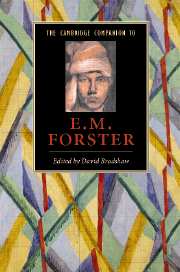Book contents
- Frontmatter
- Introduction
- 1 Forster’s life and life-writing
- 2 Bloomsbury and other values
- 3 Forster and England
- 4 Hellenism and the lure of Italy
- 5 Forster and the short story
- 6 Forster and the novel
- 7 Forsterian sexuality
- 8 Forster and women
- 9 A Room with a View
- 10 Howards End
- 11 Maurice
- 12 A Passage to India
- 13 Forster and modernism
- 14 Forster as literary critic
- 15 Filmed Forster
- 16 Postcolonial Forster
- Further reading
- Index
- Series List
1 - Forster’s life and life-writing
Published online by Cambridge University Press: 28 September 2007
- Frontmatter
- Introduction
- 1 Forster’s life and life-writing
- 2 Bloomsbury and other values
- 3 Forster and England
- 4 Hellenism and the lure of Italy
- 5 Forster and the short story
- 6 Forster and the novel
- 7 Forsterian sexuality
- 8 Forster and women
- 9 A Room with a View
- 10 Howards End
- 11 Maurice
- 12 A Passage to India
- 13 Forster and modernism
- 14 Forster as literary critic
- 15 Filmed Forster
- 16 Postcolonial Forster
- Further reading
- Index
- Series List
Summary
When A Passage to India was published in 1924, Forster feared - rightly - that it would be his last novel. He was only forty-five, in good health, and, as it turned out, still had half his life ahead of him, during most of which he remained an active man of letters. The central question for his literary biography, then, is why he stopped writing novels so early in his career. He didn't stop writing. But his subsequent work takes other forms: stories, essays, reviews, broadcasts, lectures. The only works of length, apart from essay collections, that he published after the 1920s were his three biographical books, yet he thought all this writing less significant than his novels, and continually worried that his creativity had dried up. But while it is true that he was never to recapture the incandescence of his Edwardian novels, his biographical writing is extraordinarily good; and his shift towards life-writing has its own significances, not least for the understanding of his own biography.
After he had finished his last book, in 1955, Forster asked Leonard Woolf what he might write next. Woolf, whose thoughts were perhaps already turning toward the five-volume autobiography that would prove his magnum opus, advised Forster to write his autobiography. But, as P. N. Furbank explains, it was advice Forster felt he couldn't take: 'He thought he might be able to handle isolated incidents but he did not understand his own life sufficiently to describe it as a whole.' This striking - and entirely characteristic - self-deprecation was perhaps a smokescreen, obscuring what Forster understood perfectly: that a homosexual life could not be described fully in print in the 1950s; perhaps even that the criminalisation of homosexuality had necessitated his living his life in a fragmentary way.
- Type
- Chapter
- Information
- The Cambridge Companion to E. M. Forster , pp. 8 - 31Publisher: Cambridge University PressPrint publication year: 2007
- 1
- Cited by



